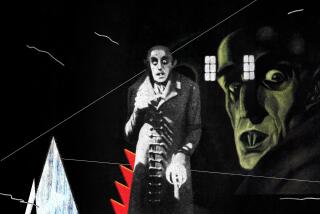Celebrating Halloween With a Pair of Horror Classics
Celebrate Halloween tonight at 8 at the Silent Movie, which will present a pair of German Expressionist classics, F.W. Murnau’s “Nosferatu: A Symphony of Horrors” (1922), the first and the greatest of the Dracula features, and Paul Wegener and Carl Boese’s brooding “The Golem” (1920), in which a rabbi in 16th-Century Prague creates a clay monster (played by Wegener) who comes alive to help the Jews combat expulsion from the ghetto on orders from the emperor.
Max Schreck’s Count Dracula is one of the cinema’s most indelible images. Cadaverous in the extreme, with pointed ears and clawlike hands, the count has black-encircled eyes that express a tormented loneliness and a fevered desperation that make him seem as if he had just stepped out of an Edvard Munch painting.
Craving fresh supplies of human blood, and no doubt human companionship as well, the count has told one of his acolytes, Renfield (Alexander Granach), a creepy Bremen estate agent, to secure a suitable residence in town. To that end Renfield dispatches “to some lost corner of the Carpathians” in Transylvania his clerk Jonathan Harker (Gustav von Wangenheim) to set the deal with the count. The year is 1838, but the count has been Nosferatu the Vampire for four centuries. . . . “Nosferatu” is a profoundly romantic film, with a deep, abiding faith in the ultimate redemptive power of love.
Information: (213) 653-2389.
A Distinctive ‘Woman’: Huang Shuqin’s “Woman Demon Human” screens Thursday at 7 p.m. in Room 202 in USC’s Taper Hall of Humanities as part of the university’s International Film Club’s “Women Make Movies” series. It begins as many films about actresses do: with the heroine sitting at her dressing table looking back on her life as she applies her makeup. Although classic in form, this exquisite film by one of China’s few women directors has so many distinctive details and is so clearly the work of a liberated, reflective sensibility that it offers an altogether fresh experience.
Huang’s lovely heroine Qiu Yin (Xu Shouli) is only 30, but her life has already been filled with both accomplishment and heartbreak. The child of traveling opera performers whose mother runs off with another man, Qiu Yin deals with every one of life’s challenges and setbacks by throwing herself into her work. Determined to break precedent, she ultimately wins the chance to play the Chinese opera’s more demanding male roles, winning fame as the ferocious-looking ghost of ancient Chinese folklore, Zhong Kui, who zealously tries to marry off his beloved sister.
Throughout the film, a dream-like performance of this one-act opera is intercut with Qiu Yin’s memories as she gradually accepts that this stellar demon has married her to the stage. What could have been a soapy, old-fashioned “woman’s picture” becomes a reverie on art as a way to salvation.
Information: (213) 740-2666.
A Funny ‘Blond’: On a far lighter note Yves Robert’s hilarious 1972 “The Tall Blond Man With One Black Shoe” screens Thursday at 7:30 p.m. at UCLA’s Melnitz Theater as part of its film archive’s Gaumont retrospective.
A satire on the absurd, potentially lethal excesses of government espionage, it’s so funny that one is in constant danger of forgetting that the points it makes so deftly couldn’t be more serious. An elaborate prologue triggers an avalanche of inspired mayhem as Pierre Richard’s concert violinist is mistaken for a spy, caught in a rivalry between government agents.
One of the funniest French comedies ever, it is funnier than the 1985 remake, “The Man with One Red Shoe” with Tom Hanks.
Information: (310) 206-FILM.
Gypsy Culture: Tony Gatlif’s rapturously beautiful “Latcho Drom” (“Safe Journey”), which opens a one-week run at the Nuart Friday, celebrates the sustaining power of music in Gypsy culture, as he retraces the migration of the Rom people from India that began 1,000 years ago.
As he moves through the Mideast to Eastern and Western Europe, he films Gypsies singing and dancing amid vignettes of their nomadic existence, marked by hardship and discrimination to this day. The images are as glorious as the music, which is alternately joyous and mournful.
Most memorable is an older woman’s haunting lament for the Gypsies who died at Auschwitz.
Information: (310) 478-6379.
More to Read
The biggest entertainment stories
Get our big stories about Hollywood, film, television, music, arts, culture and more right in your inbox as soon as they publish.
You may occasionally receive promotional content from the Los Angeles Times.










